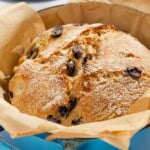Olive Bread
Crusty, crunchy and delicious! You can use your favorite pitted olives, but I like to use a mix of Kalamata and green olives for a variety of texture and flavor. This is an extra easy, beginner-friendly recipe with one thing to keep in mind: This is a higher hydration dough and is therefore sticky. It can be nerve-racking if you’re not used to working with sticky doughs, but try not to add too much flour to the dough. Instead, coat your hands with flour while you shape it into a ball. Or use a dough scraper, which sticks less than your hands. Make sure to coat the tea towel well with flour before adding the dough for the second rise.
Servings: 8
Ingredients
- 3 1/2 cups (420g) bread flour, plus more flour for dusting
- 1 teaspoon kosher salt
- 3/4 teaspoon instant yeast
- 1 1/3 cups (320ml) water
- 1 packed cup (150g) pitted olives, roughly chopped or torn in half
- 1 tablespoon extra virgin olive oil
Instructions
- Mix the dough: In a large mixing bowl, whisk together the flour, salt, and yeast. Add the olives, water, and olive oil and mix with a wooden spoon until the dough comes together and the flour is moistened.
- First rise: Cover the bowl and leave it to rise overnight until more than doubled in size, 12 to 18 hours.
- Shape the dough into a ball: Lightly dust a work surface with flour. Tip the bowl slightly and use a dough scraper or rubber spatula to gently remove the dough from the bowl onto the work surface. Gently fold the dough into itself, shaping it into a ball.
- Second rise: Generously dust a tea towel with flour and place the dough onto the towel, seam side down. Loosely fold the towel over the dough and place it into a mixing bowl. Leave it to rise in a warm spot until almost doubled, about 2 hours.
- Preheat the oven: 30 minutes before the dough has finished rising, arrange a rack in the lower third of the oven, set a 6 to 8-quart Dutch oven on the rack, and preheat to 475°F.
- Bake the bread: Use oven mitts to carefully remove the preheated pot from the oven and remove the lid. Use the tea towel to invert the dough onto a piece of parchment paper. Using the edges of the parchment paper, lower the dough into the Dutch oven. Cover the pot and bake for 30 minutes.
- Crisp the crust: Remove the lid from the Dutch oven. Bake uncovered until the bread is golden brown, about 20 minutes longer.
- Cool: Carefully lift the bread out of the Dutch oven and let it cool completely on a wire rack before slicing.
Notes
- Shop this recipe: Visit our shop to browse quality Mediterranean ingredients including the olive oil, cumin, and Aleppo pepper used in this recipe.
- Storage: Store leftovers loosely covered at room temperature for up to 3 days.
- To freeze: Allow the bread to cool fully and wrap tightly in a layer of plastic wrap, and then in a layer of foil. Freeze for up to 3 months. Let it thaw in the refrigerator overnight or on the counter for a few hours.
- How to swap flour:
- All-purpose flour and bread flour can be used interchangeably. Bread flour can be easier to work with and the final loaf will have a softer, chewier interior, but the difference in this specific bread will be subtle.
- Whole wheat: Substitute up to half of the flour with whole wheat flour. Keep in mind that the bread will become slightly denser, as the bran in whole wheat flour will slightly hinder gluten formation.
- How to use active dry yeast: There’s enough water in the dough that you can skip blooming the yeast, but you can still bloom it if you prefer to check the yeast is alive.
- Bloom 3/4 teaspoon active dry yeast in about 1/3 cup of the called-for water, heated to between 100 and 115°F, until the yeast is dissolved and bubbly, about 5 minutes. Only add 1 cup of water to the dough for 1 1/3 cups in total.
Nutrition
Calories: 216.7kcal | Carbohydrates: 40.1g | Protein: 7g | Fat: 2.8g | Saturated Fat: 0.4g | Polyunsaturated Fat: 0.6g | Monounsaturated Fat: 1.4g | Sodium: 294.3mg | Potassium: 65.6mg | Fiber: 1.6g | Sugar: 0.2g | Vitamin A: 1.6IU | Vitamin C: 0.004mg | Calcium: 8.8mg | Iron: 0.5mg
QR code
Scan this QR code with your phone's camera to view this recipe on your mobile device.
